Hi everyone,
The topic for this second newsletter of 2019 is A Mysticete Mystery.
Should you choose to read on, I will do my best to confuse you.
“That’s nothing out of the ordinary,” you might think, but in my defence, I should clarify that the tale I am about to narrate is cetacean-generated—meaning any confusion you may experience is not (entirely) my fault.
It took me many days to parse out the details of what I witnessed and recorded, and even now, I am not sure what it all means.
The main point I will try to impress upon you through sharing this experience is that even though it is sometimes possible to work out a logical explanation for what one observes in nature with reasonable certainty of being correct (like the example in my previous newsletter, a must-read if you haven't already done so), most of the time, I see something, record whatever possible in photographic and note form, then end up scratching my head, hoping that some day additional observation, reading, or discussion with someone more knowledgeable than I am will clarify the puzzle concerned.
This particular conundrum began with this photo (#1):
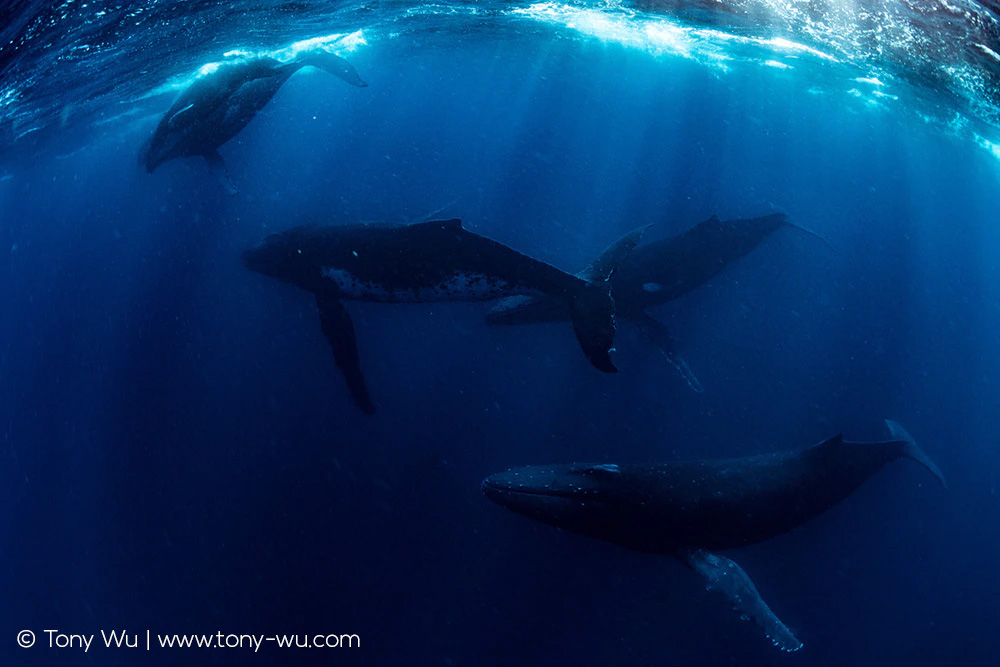
It’s kind of a crappy image, to be honest. I’m too far away. The light is wrong. The whales are scattered. There is certainly no photographic X-factor. I’ve had to crank the Lightroom sliders to stupid levels just to be able to see the subjects.
Not exactly the type of photograph you’re accustomed to seeing me share, right?
Photos like the one above are incredibly important though. It is through accumulating thousands of images like this and thinking through the associated events that I have gained insight into important aspects of humpback whale life.
Allow me to elaborate.
Background
There is a range of people reading this newsletter. Some probably know heaps about humpbacks; others haven’t had much exposure to them. So first let me provide just a teensy bit of background information, just to establish some common ground.
If you’re well-informed about Megaptera novaeangliae, skip this section if you want. If you are not familiar with the general framework of humpback life, please read on.
In very(!) simplistic terms, humpback whales spend half of the year eating (summers), half of the year not eating, but concentrating on activities related to reproduction (winters).
Take humpbacks in the northern hemisphere for example. During the summers, they can be found in high latitudes (northern waters) like Alaska, where they feast on large aggregations of baitfish and other small animals. They eat and eat and eat, absolutely gorge themselves, so that as winter approaches, they have sufficient energy stored up in the form of fat reserves that they can make their way south to breeding grounds in lower latitudes, places like Hawaii, where the whales go about the serious business of having babies and making them. Adult whales do not eat during this time.
Yes, I know that explanation is waaaaay too simple. There are many nuances and exceptions, but this rudimentary framework will do for the purposes of this story.
Photo #1 above is from winter in the southern hemisphere. The sequence of events I am going to share with you then, is from that time of year when humpbacks were engaged in reproduction-related activity—females nursing their calves, boys and girls hooking up with one another, and so forth.
Chronology
Take another look at the photo above with this context in mind.
There is an adult female in the distance at the top left corner. In front of her (closer to me/ the camera) is her calf. The three other whales are mature males, two clearly visible, one partially obscured.
What is depicted, in other words, is a female trying to raise her baby, with three males in pursuit. Why exactly mature males would be hot on the heels of a female with a baby (and thus presumably preoccupied) is not clearly understood, but this happens often enough that it’s a thing. I am not going to delve into this aspect of humpback whale life here, as I want to avoid getting sidetracked.
Now that the stage is set, let’s dive into the story.
The first time I entered the water that day (18 September 2018) was at 09:05, which is when I took photo #1.
The second was ten minutes later, at 09:15, when I saw this (photo #2):
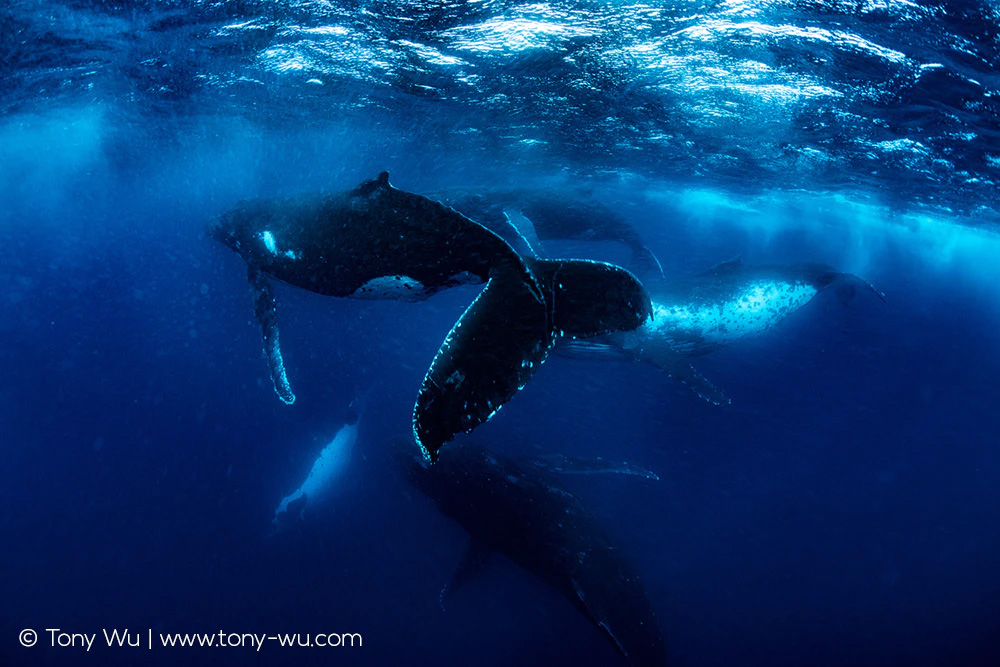
I counted five, maybe six, adult whales in the water. Since I saw no babies, I assumed these were all adult males, perhaps associated with the earlier female, perhaps just boys being boys. With rough seas, low light and lots of gunk (technical term meaning stuff) in the water, it was difficult to be certain.
A minute later, at 09:16, this (photo #3):
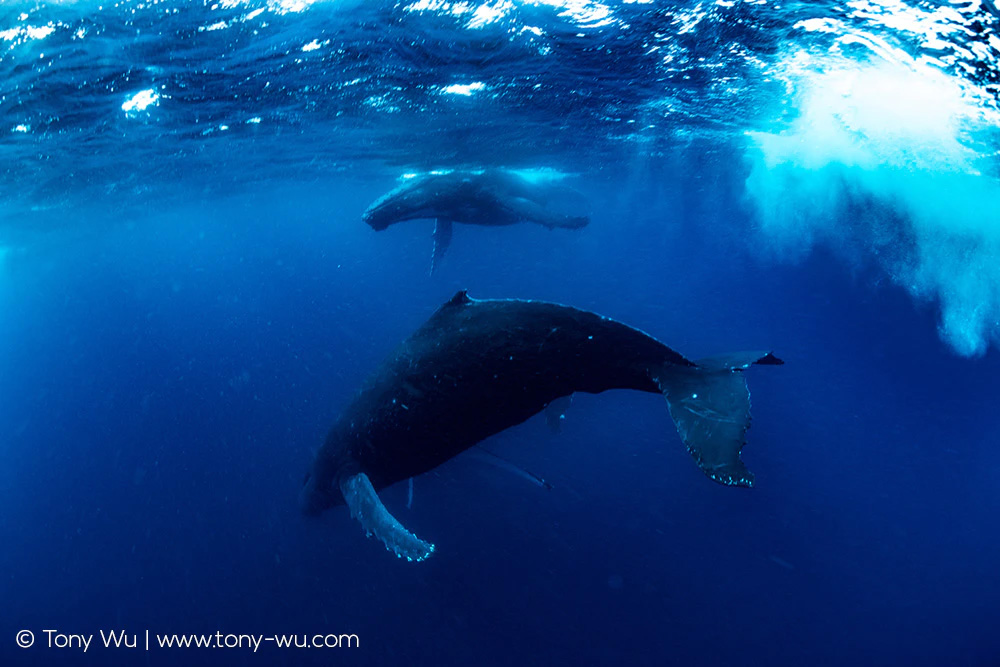
Two whales visible, another mostly obscured by the one in the foreground.
Then at 09:23, this (photo #4):
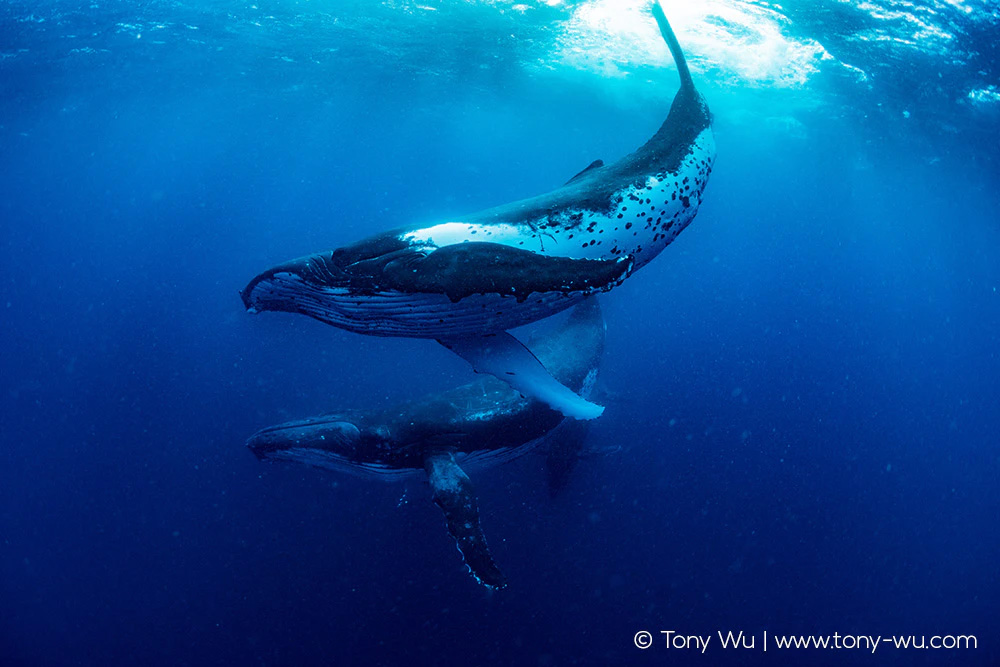
Can you see the calf in the background under the adult? My immediate impression was: “Adult female with a calf, accompanied by a male escort.”
My friend and experienced local guide thought the same. Our conversation continued while waiting to be picked up:
“Meli,” I said, “Did you see the calf?”
“Yeah,” he responded.
“Did you see…” and we both continued: “the calf swim to the escort?”
I considered remarking how cute it was that we were finishing each other’s sentences. But Meli is a big guy. He probably would not have seen the humour in such an observation, so I held my tongue (though I couldn’t help but smile a bit).
What we had both witnessed was the calf swim from its position shown in photo #4 to the individual in the foreground, the whiter of the two adult whales. It swam across and over, taking a position directly under that whitish whale as the trio swam away. Clear as day. Unfortunately, I didn’t take any photos, as this happened unexpectedly after the whales had passed.
In a very serious tone, Meli remarked how unusual that was.
I nodded. Calves usually do not leave their mothers to go to another adult.
The next time I was in the water was at 09:25, when I saw this (photo #5):
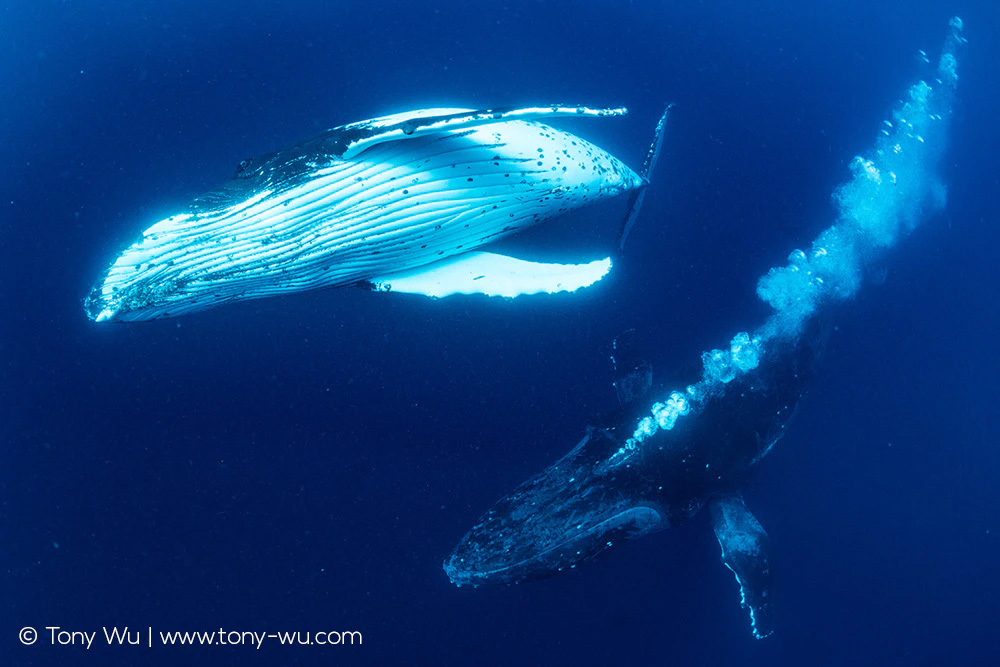
I saw the same two whales again shortly thereafter, at 09:26.
Based on the fact that we had seen so many males in the area, all worked up into a tizzy, I guessed at the time that it was two males.
Bear in mind that the seas were rocking, the whales were moving quickly, and the encounters were taking place in rapid succession. There was no time for quality thought. It was all gut instinct.
Then at 09:27, here’s what we saw (photo #6):
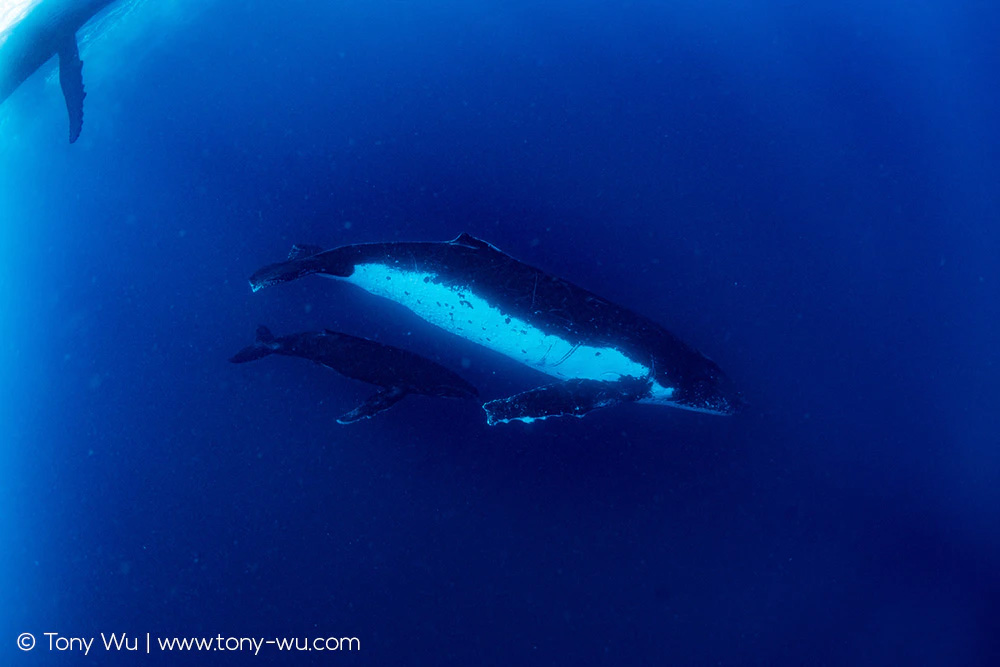
An adult female with a calf. Made perfect sense.
I figured it was the same female and calf. It had only been 22 minutes since our first encounter with them, and we were still in the same area. You can see part of another whale at the top left of the frame. Logically, that must’ve been one of the multiple males meandering about in pursuit of the mother/ calf pair. The visibility in the water was so poor that it was difficult to see much beyond that whale. It was possible, in my mind, that some or all of the other males were just out of visible range.
Then at 09:29, I had this beautiful experience (photo #7, see art print description):
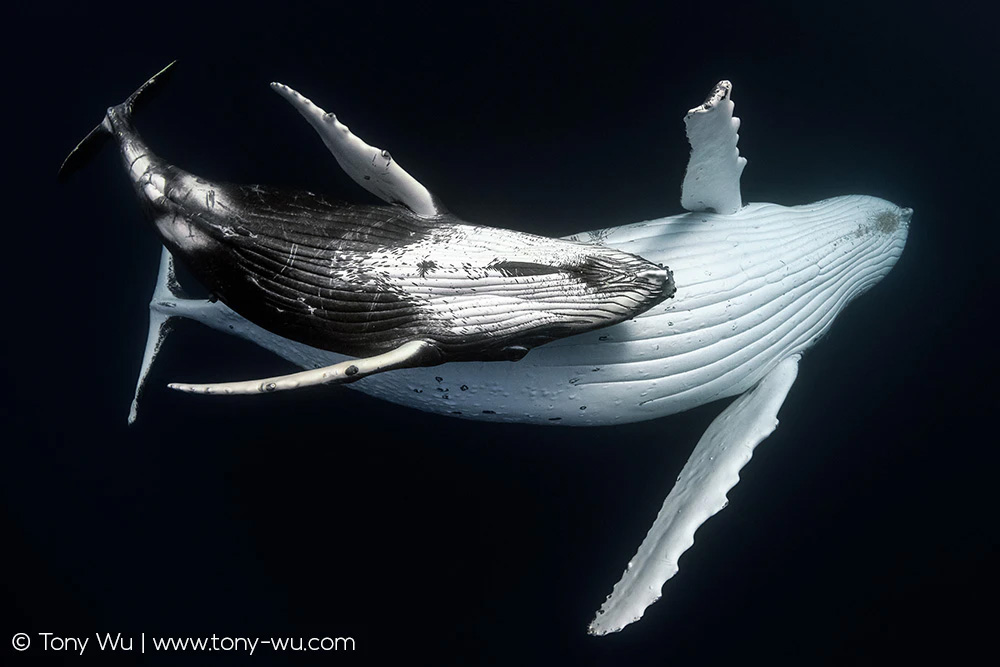
This was my fourth encounter with a female and calf, the first at 09:05 (#1), the second at 09:23 (#4), and the third at 09:27 (#6).
By this point, an armada of boats had gathered. With so many boats taking turns to put people in the water, my in-water observation time was effectively over.
From 09:37 until 10:59, we encountered the pair of whales that I had first seen at 09:25 (#5) several times, eventually leaving the area because there were too many boats and the pace of whale activity had slowed.
Later in the morning, we went back into the water with a female and calf, just a short distance from where the events set out above had taken place. A boat had radio-ed to tell us that it was the mother/ calf we had seen earlier in the morning.
The following picture is from 11:22am (photo #8), an adult female with her calf swimming above, a couple of other whales visible in the haze:
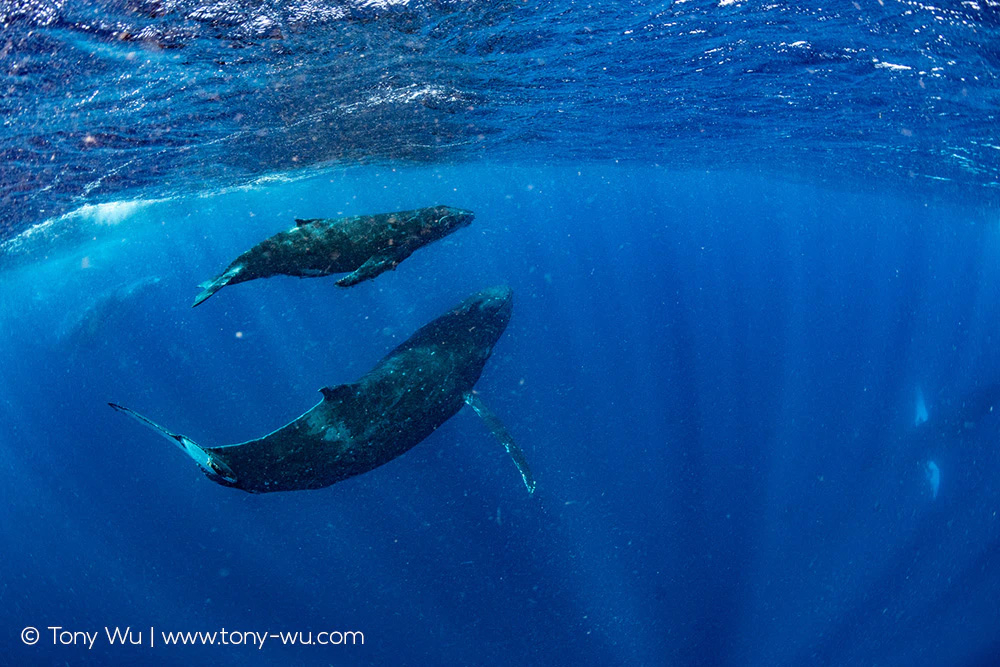
There was a lot of activity to process, especially the events that comprised the initial 25 minutes or so of the morning, when whales were popping up and swimming past from every which way.
Despite the chaos, there was one thing we had clarified by mid-morning—that the pair of whales shown in photo #5 was a male and female. I had been able to peek at the relevant areas and see that the one blowing the bubbles was male, the other female. For the balance of the morning, they had behaved in a manner consistent with whales engaged in courtship.
So that was it. Mother/ calf pair, lots of interested males, and somehow a male/ female pair in the midst of them. That was my interpretation as the day wrapped up, and it was the understanding that the dozens of other boats had as well (the captains and crew communicate information to one another).
And now, we get to the point.
Much of what I just told you is wrong.
Huh?
The version of events that I eventually worked out and will now explain is by definition a guess. Whales live in the ocean. We don’t. That very fact makes it difficult to observe most of what takes place. But I’ve been doing this for long enough that I am confident that the sequence of events I have reconstructed is reasonably accurate.
My epiphany about the events of 18 September occurred as a series of three revelations.
Revelation 1: The first thing that I worked out was the relationship among the first three photos.
Recall that #1 depicts a female with calf and three adult males. I thought that #2 showed five adult whales, and while in the water, I thought perhaps I saw a sixth in the distance.
#2 actually shows the same female with calf that is in #1, along with four adult males. “What, there is no calf visible in photo #2?” you might think.
Correct, but…

The (professionally drawn) red arrows show that the same adult female is in photos #1 and #2. The calf can’t be seen in #2, but it has to be there. Perhaps it was the shadow of a whale I thought I saw when I was in the water; perhaps it is on the far side of its mother. The mottled-whitish male whale visible in both frames is also the same.
Photo #2 therefore shows a continuation of the same scene as in #1, namely a female with a calf being pursued by adult males.
Turns out, #3 as well. How do I know? I’m glad you asked!

I realise it is difficult to see at this resolution, but the left pectoral fin of the bottom whale in photo #1 and the left pectoral fin of the foremost whale in photo #3 match, with some of the telltale marks highlighted by my beautifully hand-drawn circular-ish shapes. It is the same whale.
I did a lot of squinting and comparing of many frames at full resolution. I am certain of the above matches.
This means that from 09:05 to 09:16, there was a female/ calf pair being pursued by at least four males, two of which I can match between frames with 100% certainty. The female with calf was the same in photo #1 and #2, so I feel confident making the assumption that the center of attention for photo #3 (though not visible in-frame) was the same female with calf.
Revelation 2: After another couple of days of being obsessed (think Rain Man), it occurred to me that perhaps I should check another assumption—namely, that there was only one mother/ calf pair involved.
I had operated with this premise during the encounter because everything we had experienced took place in a very small area. We didn’t move the boat too much or far. Also, when there is a female with calf, other females with calves usually maintain a bit of distance. That isn’t absolute of course, but if you had to wager, you wouldn’t bet on seeing a bunch of females with calves frolicking together.
So one evening before dinner, I went through the sequence of events again, frame by frame, looking specifically at the female with calf.
What an idiot I had been!
Where I had assumed one female/ calf pair, there had actually been three.
The first was the match in photos #1 through #3 that I had made earlier. I also realised at this point that the mother/ calf pair in photo #4 was the same as well, again by matching the body patterns on the mother.
The second is in photos #6 and #7. The adult female is mostly white, and her right pectoral fin has a truncated tip, which is totally different from the female in photos #1 through #4.
This seems “Duh!” obvious looking at the photos now, but when encounters take place in rapid-fire succession and you’re physically and mentally drained at the end of the day, brain cells often function at less than optimal levels. It takes times to look through photos and connect the logical dots.
The third mother/ calf pair is in photo #8. Once you note the color and patterns of each whale, it becomes obvious that the whales in the last photo bear no resemblance to the whales in the first seven images.
If the seas had been more settled and the events had transpired at a more relaxed pace with more breathing room among encounters, I may have picked up on the distinguishing features of the adult females and thus known from the outset that there were multiple mother/ calf pairs. In fact, chances are high that I would have done so, as this is exactly how I have been ID-ing whales for years.
But I didn’t. So it took me a couple of days to work this out, then announce the fact to my friends, who smiled in an ambivalent manner that seemed to convey a greater proportion of pity than praise.
My efforts are so under-appreciated.
Revelation 3: Remember photo #4? The one with the original mother/ calf pair accompanied by a male escort?
Once I had worked out that there were actually three different calves and then locked down the fact that the same mother/ calf pair was involved in photos #1 through #4, I began comparing the other whales in those photos in earnest, feature by feature, to look for additional matches.
As I explained earlier, I already knew that two of the males matched across the first three photos (and associated sequences). I then tried to match the escort in photo #4 with the males in all the photos leading up that image.
Nada. Not a single match.
This wasn’t a problem in itself. There were many males out and about that day, so it was entirely possible that I had not photographed it previously, or that it had joined the party late.
And yet, something about the whale registered in my subconscious. Something about it was familiar. Something made me keep going back to the photo, keep looking at every dot and line, every patch of white. (Think Rain Man again.)
That’s when the lightbulb went off. Exploded with a bang actually.
The escort wasn’t male. It was female!!!!!!!!!!!!!!!!!!!!!!!
That rocked my world.
The whitish whale in photo #4 that both Meli and I had assumed to be a male escort was in fact the opposite gender. It was the same female that turned up less than two minutes later in photo #5, the image depicting a pair of whales engaged in courtship.
This means two things:
1. An adult female that was not obviously associated with an adult male at 09:23 (the time of photo #4) turned up at 09:25 (the time of photo #5) with a male in tow, acting all lovey-dovey for at least the next hour-and-a-half. That’s a quick hook-up by any standard, much faster than I would’ve thought it takes for a female whale to Swipe Right, but there is no doubt it happened.
2. Even more insane—when Meli and I thought we saw the calf swim from its mother to the male escort, what we in fact witnessed was a calf swim from its mother to another adult female. The inference is that the calf was comfortable with the non-mother female, and that its mother must also have been comfortable enough to let her calf go to the other female. I have never seen that happen, nor have I yet come across any reference of something like this taking place.
Mind. Blown.
Dinner that evening must have been (more) trying (than usual) for everyone else. I could barely contain my excitement. Ditto the next morning on the boat. (Again, Rain Man.)
So What?
Most photos I take are not beauty shots. The overwhelming majority are like the ones that I’ve shared here (excluding #7), not necessarily images that are ideal for prints or contests, but far from useless.
As soon as I get the chance, I go through my photos one by one, sequence by sequence—in order to glean whatever I can about the physical characteristics, behaviour, social life, etc. of the subjects involved.
Most often there is nothing unusual, or I see things that are already reasonably well documented. But every once in a while, there is a surprise, or sometime more than one, as was the case here.
As I mentioned at the beginning of the newsletter, I am still not sure what implications any of this has in the greater context of humpback whale life, but I have no doubt that all of it is important.
That a calf can happily swim from its mother to another adult female implies the possible existence of trust, of a relationship, between the adults. It is not proof-positive in the laboratory double-blind test sense, but how often are you going to get humpback whales to cooperate with people in white lab coats running controlled experiments?
That an adult female can, in less than two minutes, go from single and unencumbered to paired-off with a male that she stays with for at least an hour and half (most probably longer) suggests that it might be possible for the pairing process to happen rapidly. It is of course also possible that the two were already together, that the male simply wasn’t visible in photo #5. From previous experience, I think that second scenario unlikely, but the uncertainty inherent to parsing out meaning from snippets of disjointed observation means that I cannot be sure.
Above all, this single morning of activity underscored for my friends/ victims something that I keep saying.
Getting into the water to take pretty pictures might be fun (or frustrating, or both), but if you don’t pay attention, you can easily miss the important and interesting stuff.
Most people do.
ars gratia scientiae